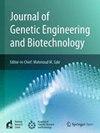Fmp45通过Ptc2相互作用促进Rad53去磷酸化,从而减弱检查点信号并维持基因组稳定性
IF 2.8
Q3 Biochemistry, Genetics and Molecular Biology
Journal of Genetic Engineering and Biotechnology
Pub Date : 2025-09-16
DOI:10.1016/j.jgeb.2025.100567
引用次数: 0
摘要
双链断裂(DSBs)是通过DNA损伤检查点途径、同源重组(HR)和非同源末端连接(NHEJ)机制的协同作用进行修复的。鉴于DSB修复网络的复杂性,鉴定新的调控因子对于全面了解基因组稳定性维持仍然至关重要。Fmp45是一种膜蛋白,以前与盐胁迫反应有关,但在DNA修复中没有已知的作用,在多个DNA损伤相关的转录组数据集中被发现上调(GEO: GSE83454, GSE155701, GSE74642)。这一观察结果使我们假设Fmp45可能代表了DSB修复机制中以前未被识别的组成部分。在这项研究中,我们证明了Fmp45在酿酒酵母的DSB反应中起着玉米苷特异性调节剂的作用。方法分析生长表型,研究FMP45缺失(fmp45Δ)及其与其他基因的遗传相互作用,Western blotting检测蛋白表达和Rad53磷酸化,激光共聚焦显微镜分析蛋白定位,流式细胞术检测细胞周期进程,酵母双杂交检测蛋白-蛋白相互作用。结果fmp45Δ突变体对zeocin诱导的DSBs过敏,但对羟基脲、甲磺酸甲酯、4-硝基喹啉-1-氧化物或喜树碱引起的DNA损伤不敏感。遗传互作分析显示,Fmp45与检查点基因Rad9有协同作用,但与hr相关基因(Sae2、Exo1)或NHEJ因子yku70无协同作用。激光共聚焦显微镜证实,FMP45缺失没有损害Rad51的核定位,Rad51是hr介导的DNA链入侵的关键介质。进一步分析Rad53磷酸化/去磷酸化动力学,fmp45Δ与磷酸酶(ptc2Δ, pph3Δ)和检查点效应(rad9Δ, mrc1Δ)突变体的生长表型,细胞周期分析和酵母双杂交分析表明,Fmp45与Ptc2相互作用促进Rad53去磷酸化,从而防止过度的细胞周期停滞。这些发现阐明了确保DNA损伤及时恢复和基因组稳定性的关键检查点-磷酸酶协调机制,确定了Fmp45是dsb后DNA修复保真度与细胞周期恢复之间的关键调节因子。本文章由计算机程序翻译,如有差异,请以英文原文为准。
Fmp45 promotes Rad53 dephosphorylation via Ptc2 interaction to attenuate checkpoint signaling and maintain genome stability
Background
Double-strand breaks (DSBs) are repaired through the coordinated action of DNA damage checkpoint pathways, homologous recombination (HR), and non-homologous end joining (NHEJ) mechanisms. Given the complexity of DSB repair networks, the identification of novel regulatory factors remains essential for a comprehensive understanding of genomic stability maintenance. Fmp45, a membrane protein previously implicated in salt stress response but with no known role in DNA repair, was found to be upregulated in multiple DNA damage-related transcriptomic datasets (GEO: GSE83454, GSE155701, GSE74642). This observation led us to hypothesize that Fmp45 might represent a previously unrecognized component of the DSB repair machinery. In this study, we demonstrate that Fmp45 functions as a zeocin-specific modulator of the DSB response in Saccharomyces cerevisiae.
Methods
Growth phenotypes were analysed to investigate FMP45 deletion (fmp45Δ) and its genetic interactions with other genes, protein expression and Rad53 phosphorylation was assessed by Western blotting, protein localization was analysed by Laser confocal microscopy, cell cycle progression was determined by flow cytometry, and protein–protein interactions was probed yeast two-hybrid assays.
Results
Growth assays revealed that fmp45Δ mutants exhibited hypersensitivity to DSBs induced by zeocin but not to other DNA lesions caused by hydroxyurea, methyl methanesulfonate, 4-nitroquinoline-1-oxide, or camptothecin. Genetic interaction analysis showed that Fmp45 cooperated with checkpoint gene Rad9 but not with HR-related genes (Sae2, Exo1) or NHEJ factor yku70. Laser confocal microscopy confirmed that FMP45 deletion did not impair nuclear localization of Rad51, a key mediator of HR-mediated DNA strand invasion. Further analysis of Rad53 phosphorylation/dephosphorylation dynamics, growth phenotypes of fmp45Δ with phosphatase (ptc2Δ, pph3Δ) and checkpoint effector (rad9Δ, mrc1Δ) mutants, cell cycle profiling, and yeast two-hybrid assays demonstrated that Fmp45 interacts with Ptc2 to promote Rad53 dephosphorylation, thereby preventing excessive cell cycle arrest.
Conclusion
These findings elucidate a critical checkpoint-phosphatase coordination mechanism ensuring timely DNA damage recovery and genomic stability, identifying Fmp45 as a key regulator balancing DNA repair fidelity with cell cycle resumption following DSBs.
求助全文
通过发布文献求助,成功后即可免费获取论文全文。
去求助
来源期刊

Journal of Genetic Engineering and Biotechnology
Biochemistry, Genetics and Molecular Biology-Biotechnology
CiteScore
5.70
自引率
5.70%
发文量
159
审稿时长
16 weeks
期刊介绍:
Journal of genetic engineering and biotechnology is devoted to rapid publication of full-length research papers that leads to significant contribution in advancing knowledge in genetic engineering and biotechnology and provide novel perspectives in this research area. JGEB includes all major themes related to genetic engineering and recombinant DNA. The area of interest of JGEB includes but not restricted to: •Plant genetics •Animal genetics •Bacterial enzymes •Agricultural Biotechnology, •Biochemistry, •Biophysics, •Bioinformatics, •Environmental Biotechnology, •Industrial Biotechnology, •Microbial biotechnology, •Medical Biotechnology, •Bioenergy, Biosafety, •Biosecurity, •Bioethics, •GMOS, •Genomic, •Proteomic JGEB accepts
 求助内容:
求助内容: 应助结果提醒方式:
应助结果提醒方式:


